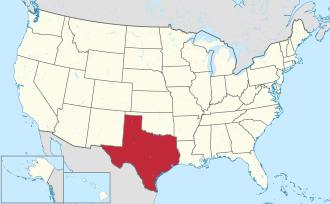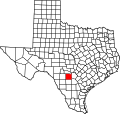History
The county is named after the Medina River, which was named in 1689 after Spanish cartographer Pedro de Medina by Spanish explorer Alonso de Leon, the first European to encounter the river. [4] Because Pedro de Medina derived his surname from the Andalusian city of Medina-Sidonia, the name Medina comes from the Arabic for city.
The Texas Legislature formed Medina County on February 12, 1848, and enlarged it on February 1, 1850, using land taken from Bexar County. Castroville was the county seat, and the county erected the first permanent courthouse there in 1854. The county seat moved to Hondo in 1892, and a new courthouse was completed there in 1893. [5]
Texas-Indian Wars
The county was home to tribes such as the Lipan Apache, Coahuiltecan, and Tonkawa.
The county was subject to frequent Comanche and Kiowa raids during the early-late 1800s. Battles like the Battle of Seco Creek in 1838 highlight the conflicts with Native Americans in the county. In 1862, Comanches kidnapped 3 children 10 miles south of Bandera. [6] Also, in 1866, Lipan Apaches killed and kidnapped 2 young settlers on Hondo Creek. On June 11, 1873, Comanches attacked four settlers on Verde Creek near modern day Hondo. [7] By 1875, the Comanches were done raiding the county. Although the Comanche were gone, other tribes, like the Lipan Apaches and Kickapoos still were raiding the county. The last Indian raid in the county happened on April 22, 1877, when 19-year-old Joe Wilton was killed by Kickapoo Indians at Black Creek near Devine, marking the end of the American Indian Wars In Medina County. [8] [9]
Demographics
Historical population| Census | Pop. | Note | %± |
|---|
| 1850 | 909 | | — |
|---|
| 1860 | 1,838 | | 102.2% |
|---|
| 1870 | 2,078 | | 13.1% |
|---|
| 1880 | 4,492 | | 116.2% |
|---|
| 1890 | 5,730 | | 27.6% |
|---|
| 1900 | 7,783 | | 35.8% |
|---|
| 1910 | 13,415 | | 72.4% |
|---|
| 1920 | 11,679 | | −12.9% |
|---|
| 1930 | 13,989 | | 19.8% |
|---|
| 1940 | 16,106 | | 15.1% |
|---|
| 1950 | 17,013 | | 5.6% |
|---|
| 1960 | 18,904 | | 11.1% |
|---|
| 1970 | 20,249 | | 7.1% |
|---|
| 1980 | 23,164 | | 14.4% |
|---|
| 1990 | 27,312 | | 17.9% |
|---|
| 2000 | 39,304 | | 43.9% |
|---|
| 2010 | 46,006 | | 17.1% |
|---|
| 2020 | 50,748 | | 10.3% |
|---|
|
Medina County, Texas – Racial and ethnic composition
Note: the US Census treats Hispanic/Latino as an ethnic category. This table excludes Latinos from the racial categories and assigns them to a separate category. Hispanics/Latinos may be of any race.| Race / Ethnicity (NH = Non-Hispanic) | Pop 2000 [15] | Pop 2010 [13] | Pop 2020 [14] | % 2000 | % 2010 | % 2020 |
|---|
| White alone (NH) | 19,919 | 21,408 | 22,324 | 50.68% | 46.53% | 43.99% |
| Black or African American alone (NH) | 801 | 913 | 1,252 | 2.04% | 1.98% | 2.47% |
| Native American or Alaska Native alone (NH) | 144 | 146 | 158 | 0.37% | 0.32% | 0.31% |
| Asian alone (NH) | 117 | 272 | 215 | 0.30% | 0.59% | 0.42% |
| Pacific Islander alone (NH) | 17 | 24 | 38 | 0.04% | 0.05% | 0.07% |
| Other race alone (NH) | 50 | 28 | 188 | 0.13% | 0.06% | 0.37% |
| Mixed race or multiracial (NH) | 383 | 344 | 1,118 | 0.97% | 0.75% | 2.20% |
| Hispanic or Latino (any race) | 17,873 | 22,871 | 25,455 | 45.47% | 49.71% | 50.16% |
| Total | 39,304 | 46,006 | 50,748 | 100.00% | 100.00% | 100.00% |
As of the census [16] of 2000, 39,304 people, 12,880 households, and 10,136 families were residing in the county. The population density was 30 people per square mile (12 people/km2). The 14,826 housing units had an average density of 11 units per square mile (4.2/km2). The racial makeup of the county was 79.38% White, 2.20% Black or African American, 0.68% Native American, 0.33% Asian, 0.05% Pacific Islander, 14.48% from other races, and 2.88% from two or more races. About 45.47% of the population were Hispanics or Latinos of any race.
Of the 12,880 households, 39.1% had children under 18 living with them, 63.2% were married couples living together, 11.1% had a female householder with no husband present, and 21.30% were not families. About 18.2% of all households were made up of individuals, and 8.2% had someone living alone who was 65 or older. The average household size was 2.91 and the average family size was 3.30.
In the county, the age distribution was 29.0% under 18, 8.4% from 18 to 24, 28.7% from 25 to 44, 21.5% from 45 to 64, and 12.4% who were 65 or older. The median age was 34 years. For every 100 females, there were 105.60 males. For every 100 females 18 and over, there were 104.90 males.
The median income for a household in the county was $36,063, and for a family was $40,288. Males had a median income of $27,045 versus $21,734 for females. The per capita income for the county was $15,210. About 12.00% of families and 15.40% of the population were below the poverty line, including 19.80% of those under age 18 and 15.60% of those age 65 or over.
This page is based on this
Wikipedia article Text is available under the
CC BY-SA 4.0 license; additional terms may apply.
Images, videos and audio are available under their respective licenses.










